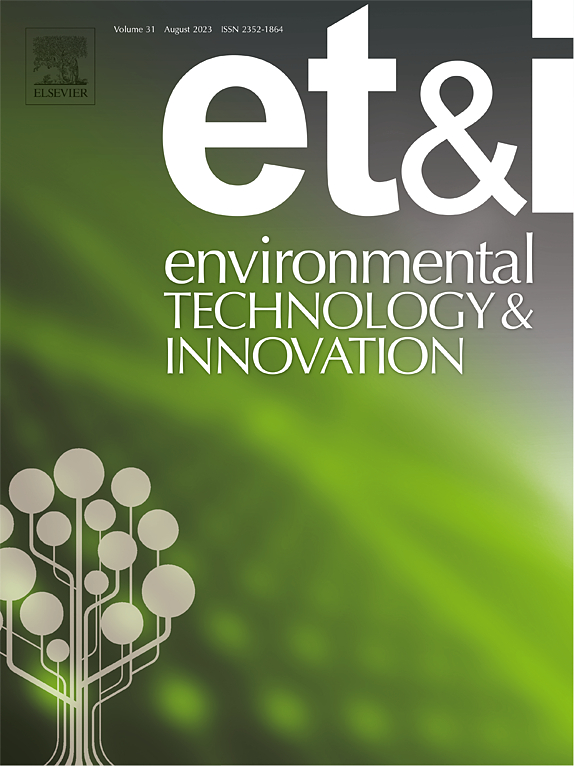基于机器学习算法的数据驱动的PM2.5三维预测模型的开发
IF 6.7
2区 环境科学与生态学
Q1 BIOTECHNOLOGY & APPLIED MICROBIOLOGY
引用次数: 0
摘要
细颗粒物(PM2.5)污染是一个全球性的环境问题,对空气质量和人类健康产生重大影响。准确的预测对于缓解PM2.5污染、减少其对环境和健康的影响至关重要。然而,目前数据驱动的PM2.5预测模型没有充分考虑垂直分布格局和源排放的贡献,无法实现对PM2.5更广泛、更准确的预测。本研究介绍了一种利用多源数据和机器学习算法以高时空分辨率预测三维(3D)空气质量的新方法。具体而言,我们通过将气象数据、人为排放清单数据、空气质量监测数据和卫星遥感数据标准化并整合到一个三维数据集中,开发了一个两阶段的3D PM2.5预测模型。第一阶段,利用随机森林(RF)模型估算气溶胶光学深度(AOD)和臭氧(O3)密度的时空分布。在第二阶段,我们进一步使用这些估计值来预测另一个RF模型在地表和海拔水平上的每小时PM2.5浓度。为了提高预测效果,对预测的PM2.5浓度进行了动态修正。使用该模型,我们预测了未来72 小时的PM2.5浓度,并根据中国山东省的监测数据验证了时空波动。此外,我们评估了当地排放的贡献,并评估了当地减排措施对空气质量的改善。我们的研究结果证实了数据驱动的机器学习模型在区域尺度上进行三维空气质量预测的能力,强调了区域排放控制对改善当地空气质量的重要性。本文章由计算机程序翻译,如有差异,请以英文原文为准。
Development of a data-driven three-dimensional PM2.5 forecast model based on machine learning algorithms
Fine particle matter (PM2.5) pollution is a global environmental problem and has significant impacts on air quality and human health. Accurate prediction is crucial for mitigating PM2.5 pollution and reducing its environmental and health impacts. However, the current data-driven PM2.5 prediction model does not fully consider the vertical distribution pattern and the contribution of source emissions to achieve a broader and more accurate prediction of PM2.5. This study introduces a novel approach to predict three-dimensional (3D) air quality at a high spatial-temporal resolution, with multi-source data and machine learning algorithms. Specifically, we developed a two-stage 3D PM2.5 prediction model by standardizing and integrating meteorology data, anthropogenic emission inventory data, air quality monitoring data, and satellite remote sensing data into a 3D dataset. In the first stage, we used random forest (RF) models to estimate the spatial-temporal distributions of aerosol optical depth (AOD) and ozone (O3) density. In the second stage, we further used these estimations to predict hourly PM2.5 concentrations at both the surface and altitude levels with another RF model. To enhance the prediction performance, dynamic corrections were implemented to the predicted PM2.5 concentrations. Using this model, we predicted PM2.5 concentrations for the next 72 hours and validated the spatial-temporal fluctuations against monitoring data across Shandong Province, China. Furthermore, we assessed the contribution of local emissions and evaluated the air quality improvement resulting from local emission reduction measures. Our findings confirm the capability of the data-driven machine learning model for 3D air quality prediction on a regional scale, emphasizing the importance of regional emission control to improve local air quality.
求助全文
通过发布文献求助,成功后即可免费获取论文全文。
去求助
来源期刊

Environmental Technology & Innovation
Environmental Science-General Environmental Science
CiteScore
14.00
自引率
4.20%
发文量
435
审稿时长
74 days
期刊介绍:
Environmental Technology & Innovation adopts a challenge-oriented approach to solutions by integrating natural sciences to promote a sustainable future. The journal aims to foster the creation and development of innovative products, technologies, and ideas that enhance the environment, with impacts across soil, air, water, and food in rural and urban areas.
As a platform for disseminating scientific evidence for environmental protection and sustainable development, the journal emphasizes fundamental science, methodologies, tools, techniques, and policy considerations. It emphasizes the importance of science and technology in environmental benefits, including smarter, cleaner technologies for environmental protection, more efficient resource processing methods, and the evidence supporting their effectiveness.
 求助内容:
求助内容: 应助结果提醒方式:
应助结果提醒方式:


